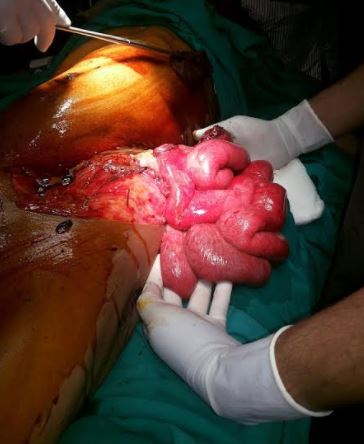[1]
Revell MA,Pugh MA,McGhee M, Gastrointestinal Traumatic Injuries: Gastrointestinal Perforation. Critical care nursing clinics of North America. 2018 Mar
[PubMed PMID: 29413211]
[2]
Nishimura T,Sakata H,Yamada T,Terashima M,Shirai K,Yamada I,Kotani J, Different Patterns in Abdominal Stab Wound in the Self-Inflicted and Assaulted Patients: An Observational Analysis of Single Center Experience. The Kobe journal of medical sciences. 2017 Jul 20
[PubMed PMID: 29434169]
[3]
Arafat S,Alsabek MB,Ahmad M,Hamo I,Munder E, Penetrating abdominal injuries during the Syrian war: Patterns and factors affecting mortality rates. Injury. 2017 May
[PubMed PMID: 28238300]
[4]
McDonald AA,Robinson BRH,Alarcon L,Bosarge PL,Dorion H,Haut ER,Juern J,Madbak F,Reddy S,Weiss P,Como JJ, Evaluation and management of traumatic diaphragmatic injuries: A Practice Management Guideline from the Eastern Association for the Surgery of Trauma. The journal of trauma and acute care surgery. 2018 Jul
[PubMed PMID: 29613959]
[5]
Wortman JR,Uyeda JW,Fulwadhva UP,Sodickson AD, Dual-Energy CT for Abdominal and Pelvic Trauma. Radiographics : a review publication of the Radiological Society of North America, Inc. 2018 Mar-Apr
[PubMed PMID: 29528816]
[6]
Sarici İS,Kalayci MU, Is computed tomography tractography reliable in patients with anterior abdominal stab wounds? The American journal of emergency medicine. 2018 Aug
[PubMed PMID: 29402685]
[7]
Phillips B, Holzmer S, Turco L, Mirzaie M, Mause E, Mause A, Person A, Leslie SW, Cornell DL, Wagner M, Bertellotti R, Asensio JA. Trauma to the bladder and ureter: a review of diagnosis, management, and prognosis. European journal of trauma and emergency surgery : official publication of the European Trauma Society. 2017 Dec:43(6):763-773. doi: 10.1007/s00068-017-0817-3. Epub 2017 Jul 20
[PubMed PMID: 28730297]
[8]
Givergis R,Munnangi S,Fayaz M Fomani K,Boutin A,Zapata LC,Angus LG, Evaluation of massive transfusion protocol practices by type of trauma at a level I trauma center. Chinese journal of traumatology = Zhonghua chuang shang za zhi. 2018 Apr 18
[PubMed PMID: 29776837]
[9]
Tarchouli M,Elabsi M,Njoumi N,Essarghini M,Echarrab M,Chkoff MR, Liver trauma: What current management? Hepatobiliary
[PubMed PMID: 29428102]
[10]
Malkomes P,Störmann P,El Youzouri H,Wutzler S,Marzi I,Vogl T,Bechstein WO,Habbe N, Characteristics and management of penetrating abdominal injuries in a German level I trauma center. European journal of trauma and emergency surgery : official publication of the European Trauma Society. 2018 Jan 22
[PubMed PMID: 29356844]
[11]
Pothmann CEM,Sprengel K,Alkadhi H,Osterhoff G,Allemann F,Jentzsch T,Jukema G,Pape HC,Simmen HP,Neuhaus V, [Abdominal injuries in polytraumatized adults : Systematic review]. Der Unfallchirurg. 2018 Feb
[PubMed PMID: 29350250]
Level 1 (high-level) evidence
[12]
Kalil M,Amaral IM, Epidemiological evaluation of hepatic trauma victims undergoing surgery. Revista do Colegio Brasileiro de Cirurgioes. 2016 Feb
[PubMed PMID: 27096853]
Level 2 (mid-level) evidence
[13]
Muckart DJ,Meumann C,Botha JB, The changing pattern of penetrating torso trauma in KwaZulu/Natal--a clinical and pathological review. South African medical journal = Suid-Afrikaanse tydskrif vir geneeskunde. 1995 Nov
[PubMed PMID: 8597008]
[14]
Weale R,Kong V,Manchev V,Bekker W,Oosthuizen G,Brysiewicz P,Laing G,Bruce J,Clarke D, Management of intra-abdominal vascular injury in trauma laparotomy: a South African experience. Canadian journal of surgery. Journal canadien de chirurgie. 2018 Apr 1
[PubMed PMID: 29583119]
[16]
Navsaria PH,Nicol AJ,Edu S,Joosten H,Almgla N,Sobnach S,McPherson D,Al-Sayari A, OUTCOMES OF FAILURE OF SELECTIVE NONOPERATIVE MANAGEMENT OF PENETRATING ABDOMINAL TRAUMA [HREC/REF: 679/2013]. South African journal of surgery. Suid-Afrikaanse tydskrif vir chirurgie. 2017 Jun
[PubMed PMID: 28876673]

